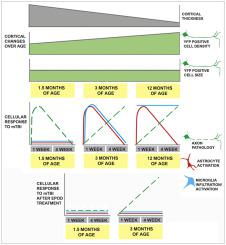当前位置:
X-MOL 学术
›
Neurobiol. Aging
›
论文详情
Our official English website, www.x-mol.net, welcomes your
feedback! (Note: you will need to create a separate account there.)
The pathological outcomes and efficacy of epothilone treatment following traumatic brain injury is determined by age
Neurobiology of Aging ( IF 3.7 ) Pub Date : 2020-09-01 , DOI: 10.1016/j.neurobiolaging.2020.03.023 Zhendan Zhu 1 , Jyoti A Chuckowree 1 , Ruth Musgrove 1 , Tracey C Dickson 1 , Catherine A Blizzard 1
Neurobiology of Aging ( IF 3.7 ) Pub Date : 2020-09-01 , DOI: 10.1016/j.neurobiolaging.2020.03.023 Zhendan Zhu 1 , Jyoti A Chuckowree 1 , Ruth Musgrove 1 , Tracey C Dickson 1 , Catherine A Blizzard 1
Affiliation

|
Traumatic brain injury (TBI) can affect individuals at any age, with the potential of causing lasting neurologic consequences. The lack of effective therapeutic solutions and recommendations for patients that acquire a TBI can be attributed, at least in part, to an inability to confidently predict long-term outcomes following TBI, and how the response of the brain differs across the life span. The purpose of this study was to determine how age specifically affects TBI outcomes in a preclinical model. Male Thy1-YFPH mice, that express yellow fluorescent protein in the cytosol of a subset of Layer V pyramidal neurons in the neocortex, were subjected to a lateral fluid percussion injury over the right parietal cortex at distinct time points throughout the life span (1.5, 3, and 12 months of age). We found that the degree of neuronal injury, astrogliosis, and microglial activation differed depending on the age of the animal when the injury occurred. Furthermore, age affected the initial injury response and how it resolved over time. Using the microtubule stabilizing agent Epothilone D, to potentially protect against these pathologic outcomes, we found that the neuronal response was different depending on age. This study clearly shows that age must be taken into account in neurologic studies and preclinical trials involving TBI, and that future therapeutic interventions must be tailored to age.
中文翻译:

脑外伤后埃坡霉素治疗的病理结果和疗效由年龄决定
创伤性脑损伤 (TBI) 可影响任何年龄的个体,并可能导致持久的神经系统后果。对获得 TBI 的患者缺乏有效的治疗解决方案和建议可至少部分归因于无法自信地预测 TBI 后的长期结果,以及大脑的反应在整个生命周期中如何不同。本研究的目的是确定年龄如何在临床前模型中具体影响 TBI 结果。雄性 Thy1-YFPH 小鼠在新皮层 V 层锥体神经元子集的细胞质中表达黄色荧光蛋白,在整个生命周期的不同时间点(1.5, 3 和 12 个月大)。我们发现,神经元损伤的程度,星形胶质细胞增生和小胶质细胞激活因损伤发生时动物的年龄而异。此外,年龄影响了最初的损伤反应以及它如何随着时间的推移而解决。使用微管稳定剂埃坡霉素 D,为了潜在地防止这些病理结果,我们发现神经元反应因年龄而异。这项研究清楚地表明,在涉及 TBI 的神经学研究和临床前试验中必须考虑年龄,并且未来的治疗干预必须根据年龄进行调整。我们发现神经元反应因年龄而异。这项研究清楚地表明,在涉及 TBI 的神经学研究和临床前试验中必须考虑年龄,并且未来的治疗干预必须根据年龄进行调整。我们发现神经元反应因年龄而异。这项研究清楚地表明,在涉及 TBI 的神经学研究和临床前试验中必须考虑年龄,并且未来的治疗干预必须根据年龄进行调整。
更新日期:2020-09-01
中文翻译:

脑外伤后埃坡霉素治疗的病理结果和疗效由年龄决定
创伤性脑损伤 (TBI) 可影响任何年龄的个体,并可能导致持久的神经系统后果。对获得 TBI 的患者缺乏有效的治疗解决方案和建议可至少部分归因于无法自信地预测 TBI 后的长期结果,以及大脑的反应在整个生命周期中如何不同。本研究的目的是确定年龄如何在临床前模型中具体影响 TBI 结果。雄性 Thy1-YFPH 小鼠在新皮层 V 层锥体神经元子集的细胞质中表达黄色荧光蛋白,在整个生命周期的不同时间点(1.5, 3 和 12 个月大)。我们发现,神经元损伤的程度,星形胶质细胞增生和小胶质细胞激活因损伤发生时动物的年龄而异。此外,年龄影响了最初的损伤反应以及它如何随着时间的推移而解决。使用微管稳定剂埃坡霉素 D,为了潜在地防止这些病理结果,我们发现神经元反应因年龄而异。这项研究清楚地表明,在涉及 TBI 的神经学研究和临床前试验中必须考虑年龄,并且未来的治疗干预必须根据年龄进行调整。我们发现神经元反应因年龄而异。这项研究清楚地表明,在涉及 TBI 的神经学研究和临床前试验中必须考虑年龄,并且未来的治疗干预必须根据年龄进行调整。我们发现神经元反应因年龄而异。这项研究清楚地表明,在涉及 TBI 的神经学研究和临床前试验中必须考虑年龄,并且未来的治疗干预必须根据年龄进行调整。











































 京公网安备 11010802027423号
京公网安备 11010802027423号